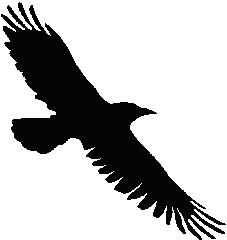
Who is she?
Morrìgan is a Celtic triple female deity, She has a number of names, such as: Great Queen, Specter Queen, Supreme War Goddess and Queen of Phantoms or Demons. Great Mother, Moon Goddess, Great White Goddess, Queen of the Fairie, Patroness of Priestesses and Witches, Queen of the Witches and Goddess of Magick.
It seems that The Morrìgan was looked at as an evil goddess, according to this quote:
 In her dark site, she is the Goddess of War, Fate and Death. As a War Goddess, she reigned over the battlefield, helping with her magick, but did not join in battles. The "Washer at the Ford" (seem washing bloody laundry prior to battle by those destined to die). With her, others like Fea (Hateful), Nemon (Venomous), Badb (Fury) and Macha (Battle) encouraged fighters to battle-madness. Marries the Dagdha at Samhain. Daughter of Ernmas, and sometimes a collective name for all three of her daughters.
Her symbol was the raven or crow. Like many Goddesses, She was a shapechanger. She often turned into a raven or hooded crow. The carrion crow is her favorite disguise. In her dark site, she is the Goddess of War, Fate and Death. As a War Goddess, she reigned over the battlefield, helping with her magick, but did not join in battles. The "Washer at the Ford" (seem washing bloody laundry prior to battle by those destined to die). With her, others like Fea (Hateful), Nemon (Venomous), Badb (Fury) and Macha (Battle) encouraged fighters to battle-madness. Marries the Dagdha at Samhain. Daughter of Ernmas, and sometimes a collective name for all three of her daughters.
Her symbol was the raven or crow. Like many Goddesses, She was a shapechanger. She often turned into a raven or hooded crow. The carrion crow is her favorite disguise.
(source: Barbara Walker, The Woman's Encyclopedia of Myths and Secrets.)
Well how about that, not really a nice girl, wouldn't you say? But not everyone seems to think that The Morrìgan was all evil:
The Morrìgan is a goddess of battle, strife and fertility. She could also appear as a beautiful Maiden. Tradition says she has nine loosed tresses on her head, a sign of her connection with the Ninefold Goddess of the Cauldron. Goddess of rivers, lakes, and fresh water. The origins of the Morrìgan seem to reach directly back to the megalithic cult of the Mothers. The Mothers usually appeared as triple goddesses and their cult was expressed through both battle ecstasy and regenerative ecstasy. It's also interesting to note that later Celtic goddesses of sovereignity (such as the trio of Eriu, Banba, and Fotla) also appear as a trio of female deities who use magic in warfare.
Now, that's a different aproach....
"Influence in the sphere of warfare, but by means of magic and incantation rather than through physical strength, is common to these beings." (source: Ross 205)
There is certainly evidence that the concept of a raven goddess of battle wasn't limited to the Irish Celts. An inscription found in France which reads Cathubodva, 'Battle Raven', shows that a similar concept was at work among the Gaulish Celts.
Cu Chulainn
|







